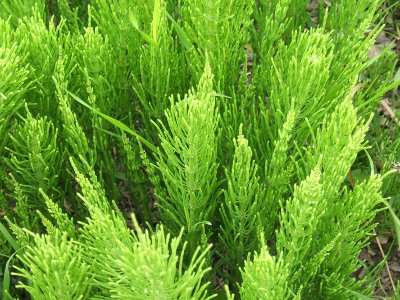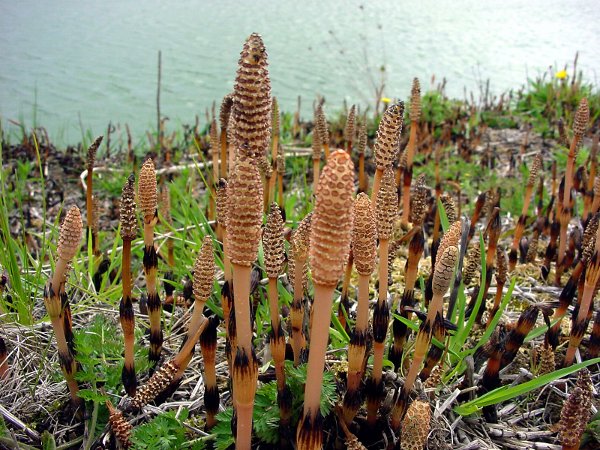Horsetail
 Common Names: Field horsetail, common horsetail, bottlebrush, foxtail, queue de renard, pinetop, jointed rush, horse pipes, mare's tail, snake grass
Common Names: Field horsetail, common horsetail, bottlebrush, foxtail, queue de renard, pinetop, jointed rush, horse pipes, mare's tail, snake grass
Scientific Name: Equisetum arvense
Climate: Temperate
Plant Description:
Is an herbaceous perennial plant in the Equisetopsida (the horsetails), native throughout the arctic and temperate regions of the northern hemisphere, including nearly all of North America.
The erect sterile stems are 10–90 cm tall and 3–5 mm diameter, with jointed segments around 2–5 cm long with whorls of side shoots at the segment joints; the side shoots have a diameter of about 1 mm. Some stems can have as many as 20 segments.
The stem is relatively straight, there are branches off the main stem, but these branches are not branched
It has separate sterile non-reproductive and fertile spore-bearing stems growing from a perennial underground rhizomatous stem system. The fertile stems are produced in early spring and are non-photosynthetic, while the green sterile stems start to grow after the fertile stems have wilted and persist through the summer until the first autumn frosts. The border of the leaf sheath is dark or with a narrow white edge.
It is sometimes confused with mare's tail, Hippuris vulgaris.
Cultivation: Horsetail grows in a wide range of conditions, in temperatures less than 5 °C to greater than 20 °C (68 °F) in areas that receive annual rainfall as low as 100 mm and as great as 2,000 mm.
The perennial plant, sometimes considered a weed, spreads quickly and can rapidly invade a garden, or other moist habits.
Field horsetail is a facultative wetland species. Field horsetail occurs in woods, fields, meadows and swamps, and moist soils alongside streams, rivers, and lakes, and in disturbed area
Field horsetail is sensitive to moisture stress; drought conditions result in a reduction in the production of new shoots.
 Uses: The plant contains several substances that can be used medicinally. The above ground parts are the ones used to make medicine. Horsetail has been used since ancient Greek and Roman times. Traditionally horsetail has been used as a medicinal herb to treat osteoporosis, tuberculosis, and kidney problems. Horsetail was also used as a diuretic (for relief of fluid retention) and to stop bleeding and heal wounds. However, there are very few reliable research studies available to solidify the claims that horsetail is safe or effective for use as a medicinal herb.
Uses: The plant contains several substances that can be used medicinally. The above ground parts are the ones used to make medicine. Horsetail has been used since ancient Greek and Roman times. Traditionally horsetail has been used as a medicinal herb to treat osteoporosis, tuberculosis, and kidney problems. Horsetail was also used as a diuretic (for relief of fluid retention) and to stop bleeding and heal wounds. However, there are very few reliable research studies available to solidify the claims that horsetail is safe or effective for use as a medicinal herb.
Native Americans and early settlers used tea made from field horsetail as a diuretic. Field horsetail was used as a cough medicine for horses, dyes for clothing. It was used for scouring and polishing objects. The young shoots were eaten either cooked or raw.
It is rich in silicon (10%), potassium, calcium, manganese, magnesium and phosphorus, phytosterols, dietary fiber, vitamins A, E and C, tannins, alkaloids, saponins, flavonoids, glycosides and caffeic acid phenolic ester.
Silica extracted from horsetail is utilized for manufacture of remineralizing and diuretic medicinal products. Other potential uses of its biogenic silica include industrial applications (abrasives, toothpaste, protective cloth, optical fibers, thickeners for paint, etc.), detergents, and cleaners. Leaf-odor constituents were used widely in the 1970's in perfumes but are little used now. These constituents can be used as food flavors and flavor enhancers, and as animal repellents.
References:
Cola de Caballo: MedlinePlus suplementos. (n.d.). Medlineplus. Retrieved November 2, 2020, from https://medlineplus.gov/spanish/druginfo/natural/843.html
Equisetum arvense. (n.d.). FEIS. Retrieved November 2, 2020, from https://www.fs.fed.us/database/feis/plants/fern/equarv/all.html
Equisetum arvense (field horsetail): Go Botany. (n.d.). Gobotany. Retrieved November 2, 2020, from https://gobotany.nativeplanttrust.org/species/equisetum/arvense/
The Health Benefits of Horsetail. (n.d.). Verywell Health. Retrieved November 2, 2020, from https://www.verywellhealth.com/horsetail-4692253
Wikipedia contributors. (2020, October 9). Equisetum arvense. Wikipedia. https://en.wikipedia.org/wiki/Equisetum_arvense
La planta Cola de Caballo (Equisetum arvense L.). (n.d.). Coladecaballo.Es. Retrieved November 2, 2020, from https://www.coladecaballo.es/
En español: Cola de caballo
